On the third anniversary of the death of Jo Cox, the IRR reports on racist violence across Europe, highlighting also cases involving police officers and soldiers.
Following the arrest in Germany on 17 June of a far-right extremist in connection with the murder of Walter Lübcke , the Christian Democrat head of city administration in Kassel, Hesse, speculation is rife that Lübcke was shot dead at close range on the terrace of his home because of his pro-migrant views. Meanwhile, in Malta the trial of two men, both serving soldiers, for the drive-by shooting of Lassana Cisse Souleymane , a 42-year-old factory worker from the Ivory Coast , raises uncomfortable questions about racism in the Maltese armed forces. In the UK, the impact of insider-outsider racism in post-Brexit Britain on the behaviour of young people is once again up for discussion, following a vicious assault by teenagers on Daniel Ezzedine, a 17-year-old German-Lebanese exchange student who is fighting for his life after a street attack in Canterbury, Kent on 6 June.
These three appalling cases may have taken place hundreds of miles apart but they constitute links in a much wider pattern of violence across Europe in which far-Right supporters are not always, but usually, the instigators. Sadly, three years since the murder of Jo Cox, politicians are still being targeted for far-right attack, but so are many others, with poor marginalised Roma, migrant and refugee communities bearing the brunt of mob attacks. The main factors – and evolutions – in this violence are as follows.
Paramilitarism, vigilantism and attacks by organised squads
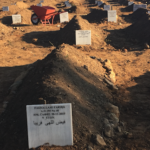
Paramilitary formations, ‘self-defence’ patrols, street vigilantism and mob behaviour often sparked off by rumours on social media of some heinous crime committed by foreigners, Muslims or Roma is very much the modern face of the far Right. In May of this year, a Greek court acquitted over 100 refugees who were arrested in April 2018 after a far-right mob, some hooded and armed, attacked them in the main square of Mytilene, the capital city of the island of Lesvos, where they were protesting at the inhumane conditions and the death of an Afghan refugee at the Moria camp. (Police sympathies for the far Right are evidenced by the fact that not a single fascist was arrested). The Refugee Support Aegean (RSA) is amongst groups documenting racial violence against migrants on the Greek islands. In a 2018 report, RSA drew attention to organised squads operating in Gera, Lesvos, going from house to house checking accommodation to see whether asylum seekers had been transferred there, and also mobilising anti-migrant sentiment, on the basis of ‘fake news’ that an abandoned factory was to be transferred into a refugee camp at an old factory. Another Greek neo-nazi vigilante group is Crypteia, which is said to be a splinter group from Golden Dawn, taking its name from a group of ancient Spartans infamous for attacking slaves. Crypteia first came to national attention after it claimed responsibility for an attack on the home of a 11 year old Afghan boy in November 2017. In March 2018, it claimed responsibility for an attack on the offices of the Afghan Community in Greece smashing computers and dousing the office in petrol and setting it ablaze.
In Spain in May 2019 there were similar incidents of organised squads of young Spaniards attacking accommodation for young unaccompanied refugees in Catalonia. In one incident , 25 people, wearing hoods and with their faces covered, broke into a shelter where 35 unaccompanied foreign minors were living and attacked the children with rocks ‘bigger than their heads’.
Anti-foreigner, anti-Roma violence and ‘fake news’
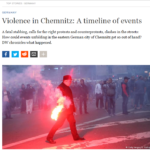 The worst example over the last year of anti-foreigner violence based on social media rumour-mongering undoubtedly occurred on 27/28 August 2018 during the anti-foreigner riots in the former industrial east German city of Chemnitz . In scenes reminiscent of the 1991 pogroms in Rostock and Hoyerswerda, police in Saxony all but lost control of the streets to the far Right. It all started after a fight at a local town festival left a German-Cuban man dead, was exploited by neo-nazis and a local far-right football association which began to spread rumours online that a German man had been stabbed to death because he was protecting women and that a second man had been killed.
The worst example over the last year of anti-foreigner violence based on social media rumour-mongering undoubtedly occurred on 27/28 August 2018 during the anti-foreigner riots in the former industrial east German city of Chemnitz . In scenes reminiscent of the 1991 pogroms in Rostock and Hoyerswerda, police in Saxony all but lost control of the streets to the far Right. It all started after a fight at a local town festival left a German-Cuban man dead, was exploited by neo-nazis and a local far-right football association which began to spread rumours online that a German man had been stabbed to death because he was protecting women and that a second man had been killed.
Two other more recent examples of these kind of street mobilisations – this time directed against Roma – have taken place in 2019 in Paris and Rome. In March 2019, anti-Roma vigilante squads mobilised in the north-eastern Paris suburbs of Clichy-sous-Bois and Bobigny, after posts on messaging apps and social media above a picture of white van circulated warning that organ trafficking and child abductions were taking place. The vigilantes vandalised vans belonging to the Roma and in some of the worst incidents, around 50 people armed with sticks set upon Roma families living in slums in the suburb of Bobigny. Voice of Roma spokesperson Anina Ciuciu said that that occurred was a ‘revival of the medieval stereotype’of Roma in which ‘Gypsies are likened to thieves and child-catchers’.

More anti-Roma incidents took place in May 2019 in the run up to the June European parliament elections this time in Italy, in the suburbs of Rome. After rumours circulated that a Bosnian Roma family, that had been evacuated from an informal Roma settlement had been given a council flat in Casal Bruciato, the self-styled ‘fascists of the third millennium’ Casa Pound seemed to have instigated – and swelled – a local protest. The Roma family had to be escorted to their new flat by the police, forced to run the gauntlet of a mob shouting ‘We don’t want you here’ and ‘You all have to burn’ with one person captured on video shouting at the mother, ‘Whore, I’ll rape you’. It wasn’t the first attempt to drive Roma out of social housing in Rome, nor was it to be the last, as diligently documented by Stefano Fasano for Equal Times. But it should also be noted that there has been concerted anti-fascist opposition amidst warning that the media are not assisting things by amplifying the far-right’s message. In another Rome neighbourhood, Tor Vergata, a local committee comprising teachers and parents was formed to support Suzana, a Roma woman and mother of four who had been victimised by the far right Azione Frontale.
Terror plots and treachery discourses
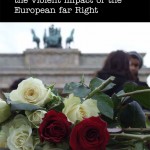 Back in 2012, when IRR published ‘Pedlars of hate: the violent impact of the European far Right’ we pointed out that not only was Europe experiencing an ‘early form of far-right terror’ but that there was disturbing evidence of collusion between far-right terror cells and elements within the police and military. That far-right cells have formed, have amassed weapons, are conspiring to carry out violence against minorities, sometimes with the connivance of police officers and soldiers, is demonstrated by a number of cases in the UK, Austria, France, Germany, Italy and Greece, with investigations ongoing or concluded including of the following: the Federation of States (Austria), Combat 18 Hellas (Greece), Revolution Chemnitz, Citizens of the Reich , Uniter Group, Freital Group(Germany), National Action (UK), which after the murder of Jo Cox in June 2016 posted a message on social media in support of her killer, stating ‘Don’t let this man’s sacrifice go in vain. #JoCox would have filled Yorkshire with more subhumans’. In many of the investigations, the far-right conspirators also had in their sights politicians, journalists and lawyers who have dared to voice pro-migrant opinions. These kind of plots, which we have seen in the UK with the National Action plot to kill the West Lancashire Labour MP Rosie Cooper in 2017, are spiralling in Germany. A number of ongoing investigations give something of the context for the murder of Kassel Christian Democrat politician Walter Lübcke.
Back in 2012, when IRR published ‘Pedlars of hate: the violent impact of the European far Right’ we pointed out that not only was Europe experiencing an ‘early form of far-right terror’ but that there was disturbing evidence of collusion between far-right terror cells and elements within the police and military. That far-right cells have formed, have amassed weapons, are conspiring to carry out violence against minorities, sometimes with the connivance of police officers and soldiers, is demonstrated by a number of cases in the UK, Austria, France, Germany, Italy and Greece, with investigations ongoing or concluded including of the following: the Federation of States (Austria), Combat 18 Hellas (Greece), Revolution Chemnitz, Citizens of the Reich , Uniter Group, Freital Group(Germany), National Action (UK), which after the murder of Jo Cox in June 2016 posted a message on social media in support of her killer, stating ‘Don’t let this man’s sacrifice go in vain. #JoCox would have filled Yorkshire with more subhumans’. In many of the investigations, the far-right conspirators also had in their sights politicians, journalists and lawyers who have dared to voice pro-migrant opinions. These kind of plots, which we have seen in the UK with the National Action plot to kill the West Lancashire Labour MP Rosie Cooper in 2017, are spiralling in Germany. A number of ongoing investigations give something of the context for the murder of Kassel Christian Democrat politician Walter Lübcke.

After Lübcke had supported Angela Merkel’s policy of allowing refugees from Syria entry to Germany at the height of the Summer 2015 refugee crisis, he became the victim of repeated death threats before he was shot dead on the terrace of his house on 2 June. And rather like National Action’s approval of the murder of Jo Cox, Lübcke’s death soon became the subject of celebration on far-right social media accounts. Following the arrest of a 45-year-old man whose DNA matched that found at the murder scene, it emerged that the suspect is a known neo-nazi with links to Combat 18 and the National Democratic Party of Germany and previous convictions for an attempted pipe bomb attack on a home on a shelter for asylum seekers in 1993 and in 2009 when he was arrested following a far-right attack on a trades union event in Dortmund. Though the suspect has not been linked to these groups, it is also well known that Citizens of the Reich and Uniter have discussed plots to murder treacherous politicians. Uniter, a secret far-right network of active and former soldiers and police officers (some reports estimate 200 soldiers are involved), which communicate via chatrooms, has been placed under state surveillance in Germany. The Berlin newspaper Focus claims that Uniter had discussed a plot, codenamed ‘Day X’, a reference to the day in which left-wing people will be herded together, smuggled through checkpoints, and eliminated. Members are said to have stolen weapons and ammunition from the military, discussed plans to target leaders of asylum groups that they blamed for rape, terror and social arrest and come up with a list of politicians to eliminate, including the Green MEP Claudia Roth, foreign minister Heiko Mass and ex-president Joachim Gacuck.
Politicians like 75-year-old Yiannis Boutaris, the mayor of Thessalonki known for his anti-nationalist views, and Syriza MP Theodora Tzakri, whose house was firebombed, have also been singled out for attack. Boutaris, was left with head, back and leg injuries, after being attacked by far-right nationalists in May 2018 while attending an event commemorating a second world war massacre. Greek and German journalists are also being targeted, as noted by the European Federation of Journalists. In one notorious case, again in Lesvos, Stratis Balaskas, who writes on refugee issues for the Athens News Agency, came under coordinated online death threats and verbal attacks on the streets by people aligned to the neo-nazi Golden Dawn. After Balaskas expressed fears that an organised attack squad was operating on the island, and complained of the slow pace of justice, seventeen arrests were made, with three police officers and an army officer who had also been accused of attacking another journalist, as well as refugees, amongst those arrested.
Malta’s first racial murder – suspects are soldiers
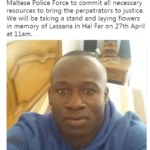
While here in the UK there is ample evidence that Tommy Robinson is popular amongst military cadets, the problem of far-right penetration of the military, as the examples above demonstrate, is far more extensive than this. There are some signs that the military are slowly waking up to the problem, especially in the UK and Germany. But the fact is that in too many cases acting police officers and soldiers have been linked to racist violence, including murder. In May, two members of the Armed Forces Malta were arrested in for the drive by shooting 6 April of Lassana Cisse Souleymane, who died after being fired at on a countryside road in Birżebbuġa, in an area notorious for attacks on migrant workers. Two other African migrant men, all residents at the Hal Far Open Centre for Refugees, were also shot at. One of the arrested soldiers allegedly confessed to involvement on a hit-and-run incident on the same road when a 17 year old migrant from Chad was injured.
How these plots feed of popular racism

But plots such as these draw strength from a much wider political culture of nativism, which is tacitly supported by most mainstream parties. (The Danish Social Democrat party even won the recent general election by embracing the policies of the Danish People’s Party). And extreme-right politicians who are now very much part of the mainstream European political landscape are too often allowed to set the terms of debate unchallenged. The extreme Right is using its position of power to popularise frameworks that threat those who oppose their asylum and immigration policies as race traitors. Repeating the behaviour of US president Donald Trump, Italy’s interior minister Matteo Salvini constantly uses his twitter account to attack search and rescue NGOS, judges and journalists who attempt to hold him to account. Most recently, he has gone on the offensive against judges, attacking the pro-migrant sympathies of three female magistrates. After he posted comments denouncing Florence judge Luciana Breggia, there were around 4,500 responses and many many death threats.

In the UK, too many recent attacks, not just on Daniel Ezzedine but also on 16-year-old Huddersfield schoolboy Jamal Hijazi, are carried out on young people by other young people. Indeed, a recent report by the NPSCC reveals that racist hate crime against children has reached a three year high. There is a sense that these young people, no doubt inspired by the likes of Tommy Robinson, as well as mainstream politicians who think it amusing to describe Muslim women wearing the burqa as ‘letter boxes’ and ‘bank robbers’ are picking up wider messages in society about who belongs and who does not belong and feel a thrill when they enforce belonging with violence.
Thanks to Graeme Atkinson for additional information.

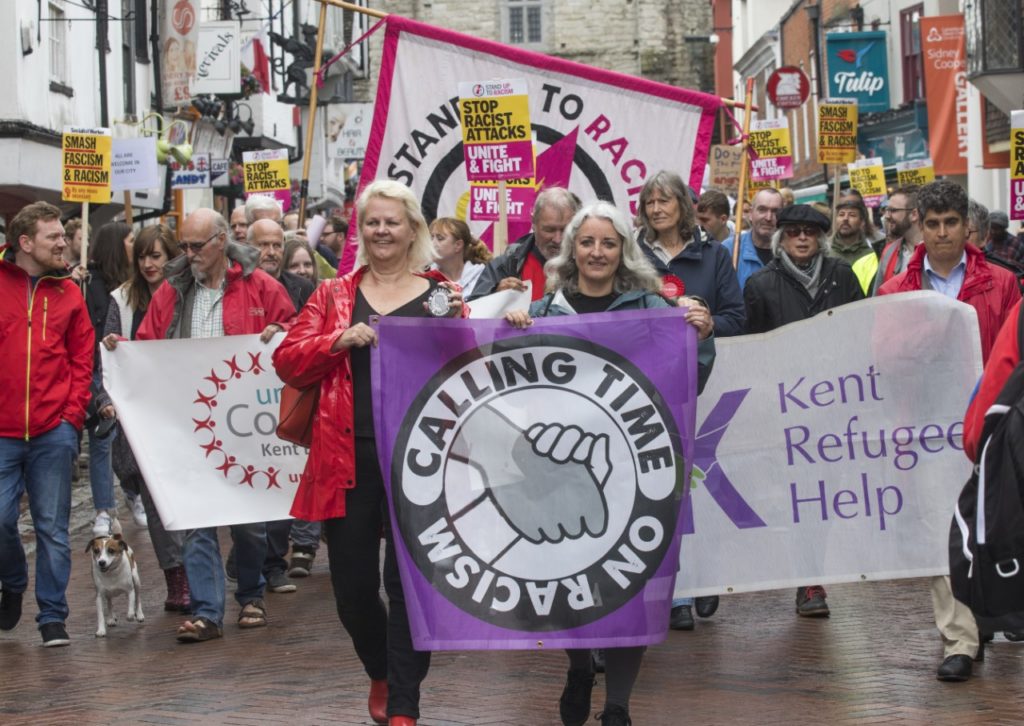
Thanks for bringing attention to the situation in Lesvos! The aftermath of the 22 April 2018 pogrom is still being felt. Over the years there have been many migrant-led protests in Mytilene’s main square. Witnesses have said that this this particular protest was attacked after Afghan protesters began praying in public. The far-right in Lesvos is fighting a holy war. In the months following the attack, fascists erected a huge crucifix on the Eastern coast facing Turkey, marking their territory on an area of beach visited by many migrants. Unfounded rumours were spread that migrants were planning to attack the city’s weekly military parade, leading to the increasing presence of the conservative and far right at these rallies. In addition, there is an undeclared colour bar in many public spaces, e.g. cafes, bars, recreational grounds, which has led to a climate of fear among the migrant population trapped on the island. Those who advocate against racism, e.g. lawyers and pro-refugee journalists, have been intimidated and harassed in the streets.
Prosecutors in Chios have acknowledged that Mytilene’s police arbitrarily punish migrants. In February, 8 migrants who had been detained for 11 months were acquitted after facing trial in Chios charged with attacking police and arson during a protest in Moria camp. Police evidence was based on the testimony of a man who had been threatened with deportation if he failed to identify the defendants. The president of the high court stated that ‘police officers in Mytilene do strange things that I cannot understand’.
Criminal charges have now been undertaken against the perpetrators of the 22 April attack. Prosecutors have for the first time in Lesvos recognised that the attack was racially motivated. But despite a nationwide epidemic of racist violence in Greece, the state now proposes to dismantle the legislative framework recognising racial motivation as an aggravating factor of violent crime.